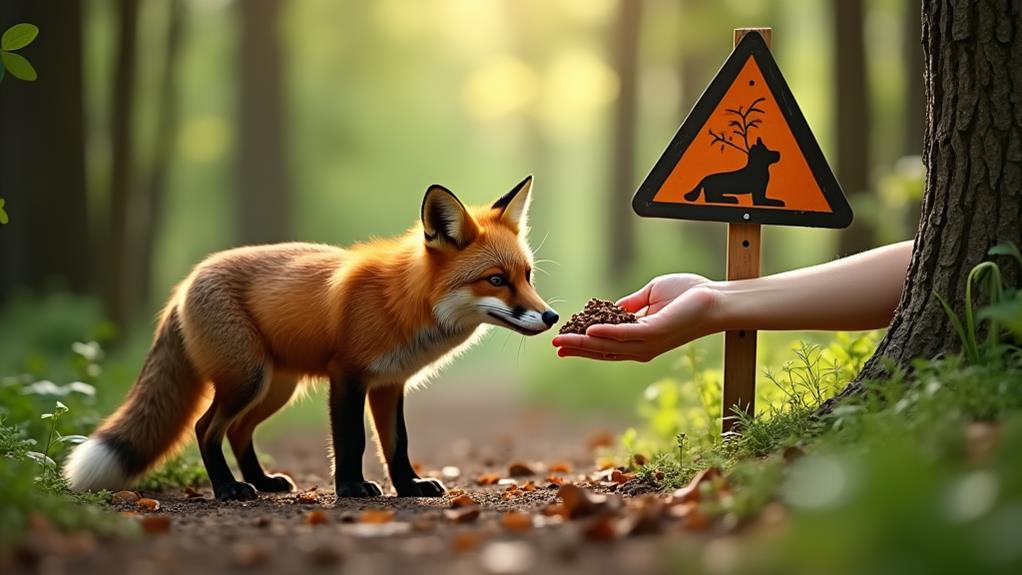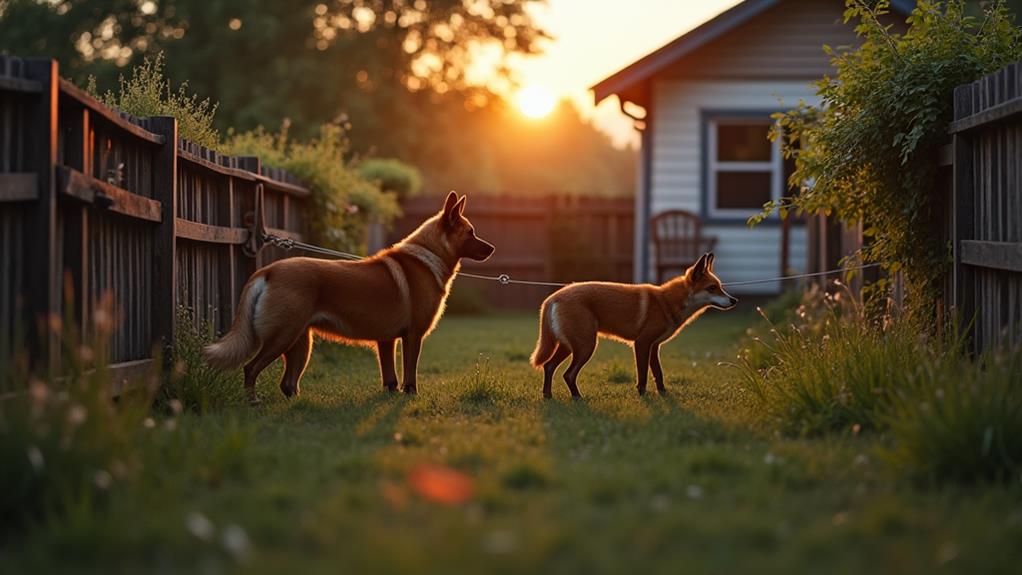Red foxes might look adorable, darting around your yard, but don't worry—they're usually harmless! These clever critters prefer to keep their distance from humans and only show aggression when they're cornered or protecting their young. While you might spot one rummaging through your trash, it's best to just give them space. They're more interested in a quick snack than causing you any trouble. However, remember that curious foxes can sometimes lead to surprises, especially around small pets. Want to learn how to safely enjoy these furry neighbors without any hiccups? Stick around for some helpful tips!
Contents
Overview of Red Fox Behavior

Red foxes, often spotted in both rural and urban settings, are mostly non-aggressive animals that prefer to avoid humans. They thrive in diverse environments like mixed landscapes where they can utilize burrows or underbrush for shelter.
While some folks think foxes might be dangerous, the truth is, they typically steer clear of us. Their behavior shows an impressive ability to adapt to different environments, which is why you might see them prowling around at odd hours, especially at night. If you spot one during the day, it's just on the lookout for a snack!
These clever creatures communicate in unique ways, using vocalizations and body language, plus they're great at marking their territory with scent.
It's crucial to understand that any rare aggression you hear about generally happens when they're defending their young kits or feeling threatened. Most of the time, foxes are just interested in small mammals or tasty fruits to munch on.
Human-Fox Interactions
When you encounter a red fox, it's easy to feel a mix of curiosity and concern. Understanding how these clever critters behave can help keep both you and them safe, especially since most foxes are more interested in scoping out your trash than starting a tussle.
Urban foxes have developed effective foraging techniques, utilizing parks and gardens to scavenge for food, which further minimizes their interaction with humans.
Understanding Fox Behavior
Understanding fox behavior is essential for safe and respectful human interactions with these elusive creatures. Most red foxes aren't aggressive towards humans; they tend to shy away from contact.
However, urban foxes exhibit strong adaptability, capable of foraging in areas near human habitation and may approach humans if they associate them with food. It's important to remember that while attacks are rare, the media can sometimes blow incidents out of proportion. Urban habitats, such as parks and residential areas, contribute to their survival, offering diverse food sources urban habitats contribute to their survival.
Curiosity drives many foxes to follow you or approach you. If they seem too interested, it could be a sign they're used to being fed—not that they're plotting an attack!
Safety Precautions Needed
Even though red foxes usually keep their distance from humans, staying safe during encounters is important. Given that about 70% of urban foxes thrive in cities, they're more likely to wander into human-populated areas than their rural counterparts. To protect yourself and your pets, it's best to keep a safe distance from foxes. If you spot one, remember that loud noises or sudden movements can encourage them to scurry away. Just don't try to win an Oscar with some dramatic gestures!
Feeding foxes might seem kind-hearted, but it can make them overly bold and reliant on human food.
Dietary adjustments allow urban foxes to adapt, but nobody wants a fox crashing your picnic! Also, make sure to supervise your pets when they're outside. Small dogs and cats can become easy targets if left unattended, especially in areas where foxes roam.
If you notice any unusual fox behavior—like staggering or aggression—don't hesitate to report it to local wildlife control. This helps keep your community safe while allowing for proper management of our furry neighbors.
Risks of Fox Encounters

Encounters with red foxes can be intriguing, but they also come with certain risks that you should be aware of. While foxes are generally not dangerous to people, most incidents arise when these curious creatures feel threatened or cornered. It's important to remember that they prefer to avoid confrontation, so maintaining a healthy distance is essential.
Urban foxes have adapted well to human surroundings. They might approach you out of curiosity, especially if you're inadvertently luring them by feeding them. Feeding can lead them to come closer, which increases the chances of an unexpected encounter.
If a fox appears overly tame or has symptoms of rabies, such as staggering, it's time to call animal control. Rabies transmission is rare, but it's better to be safe than sorry!
When you prioritize safety and respect wildlife, the chances of aggressive encounters diminish greatly. Always keep a watchful eye on your pets; foxes have been known to attack cats and small dogs if they feel like their territory is threatened.
Attacks on Pets
When it comes to red foxes and your pets, the good news is there's minimal risk involved.
Sure, these clever critters might fancy a small kitten or a toy-sized dog as a potential snack, but attacks are super rare.
Just keep an eye on your smaller animals and maybe invest in a solid enclosure, and you'll give those foxes a run for their money!
Minimal Risk to Pets
Although concerns about foxes attacking pets exist, the reality is that red foxes pose a minimal risk to adult cats and dogs. You might be wondering how often these attacks really happen, and the numbers are reassuring. In the UK, only 0.14% of cats were reported to be attacked by foxes! So, let's take a deep breath because those incidents are incredibly rare.
While it's true that small pets, particularly tiny dog breeds, can sometimes find themselves in tricky spots, foxes generally prefer to steer clear of adult animals. Healthy cats often get a free pass since stray dogs tend to send foxes running for the hills.
Remember, a healthy adult pet isn't usually on a fox's menu!
To ease your mind even further, consider securing small pets in enclosures. This step helps keep them away from any possible danger, although the risk is already very low.
Monitor Small Animals
Small animals, like tiny dog breeds and outdoor cats, require extra vigilance to guarantee their safety from potential fox encounters.
While it's true that red foxes rarely attack healthy adult cats, small dogs, especially when left unattended outside, face greater risks. Imagine stepping outside to let Fido have his fun, only to worry about a curious fox lurking nearby.
Most fox attacks involve small pets, and the numbers aren't alarming, but it pays to be cautious. You don't want to become a statistic!
Secure your yard and make sure your pet has a safe space to roam. Installing quality enclosures is a great idea, and keeping an eye on them while they're outdoors is just good sense.
Feeding Foxes: Do's and Don'ts

Feeding foxes can seem like a fun way to connect with nature, but it comes with significant risks for both the animals and your community.
When you share food with foxes, you might unintentionally encourage them to rely on humans for sustenance, which can alter their natural behavior. This can make them more aggressive in seeking food and lead to unwanted encounters.
Here are some do's and don'ts to keep in mind:
- Do provide small amounts of natural food, like fruits or vegetables, if you feel compelled to help.
- Don't feed them high-fat or sugary snacks; these can cause serious health issues.
- Do guarantee you keep a safe distance and avoid direct contact—this keeps their wild instincts intact.
- Don't leave food out in open areas, as this can encourage them to invade homes and neighborhoods.
Understanding Fox Diseases
Understanding the health risks associated with red foxes is essential for anyone who encounters them in the wild. While these clever creatures often look adorable, they can carry rabies, a serious viral disease hitting the central nervous system.
Though the chances of a fox transmitting rabies to a human are pretty low—zero reported deaths in the U.S. from 2009 to 2018—you still want to keep unvaccinated pets away from any wild wildlife drama.
Foxes can also harbor various parasites, like ticks, fleas, and worms. Eek! These little critters can pose health risks not just to curious pets but also to humans.
So, be sure to watch where you step, especially in areas where foxes roam.
You might notice that a fox showing strange behavior could be sick or in distress, acting a bit like a furry scene from a horror movie.
It's important to remember that while mange doesn't have a direct health risk to humans, a fox acting strangely might just be feeling under the weather.
Signs of Mange in Foxes

Mange in foxes, brought on by Sarcoptes scabiei mites, can be alarming to witness. If you're lucky enough to spot a fox in the wild, you may notice some signs of this disturbing condition.
Keep an eye out for:
- Excessive scratching: Foxes infected with mange often scratch and bite at their skin incessantly.
- Disheveled coat: Their fur might look patchy or scruffy, almost as if they've just rolled out of bed.
- Sores or scabs: Look for any open sores resulting from their intense itching.
- Unusual behavior: Infected foxes may seem more aggressive and less fearful of humans than healthy ones.
These signs don't just look sad; they also indicate that the fox is suffering. As they battle the discomfort of mange, you may notice them acting in ways that can mimic aggressive behavior, making it essential to keep a safe distance.
Managing Fox Dens
When you spot a fox den, it's important to know how to handle the situation.
You wouldn't want to disturb those cute kits before they're ready to venture out, right?
Let's chat about recognizing den locations, reducing disturbances, and safe ways to interact with these clever creatures!
Recognizing Den Locations
Recognizing the telltale signs of a red fox's den is essential for managing potential conflicts. You might be surprised where these crafty critters choose to set up shop! They often take refuge under structures like porches, sheds, or even rock piles. Understanding this helps you keep a friendly distance from the fox family.
To help you identify den locations, keep an eye out for these signs:
- Fresh tracks or paw prints nearby
- Burrow entrances hidden beneath brush or debris
- Scattered fur or leftover food near the den
- Sounds of kits 4-5 weeks after birth, chirping or playing
When you spot a den, it's important to avoid disturbing it, especially during those early weeks. Disturbance can stress the foxes, causing them to leave sooner than they'd like.
If you want them to vacate without any harm, consider using humane deterrents like loud noises or unpleasant scents. Plus, to prevent future visitors, secure your yard by burying hardware cloth around potential denning spots.
With these tips, you'll be well-equipped to help guarantee peace between you and the clever red foxes!
Reducing Den Disturbance
To maintain harmony with the local fox population, it's vital to minimize disturbances around their dens. These cozy spots, often tucked under porches or sheds, are important for the safety of the fox family, especially when they're raising their young. You wouldn't want to stress them out, right?
Remember, kits usually pop out 4-5 weeks after birth, so it's best to give them time to relocate naturally without interference.
If you find yourself near a den, avoid disturbing it to prevent the foxes from moving prematurely. When that happens, they might seek new shelters and could end up in conflict with people.
To encourage them to move along without harm, consider using humane deterrents like loud noises, unpleasant scents, or shiny objects. It's a gentle nudge to say, "Hey, time to go!"
For future prevention, think about burying hardware cloth around your property. This'll help keep foxes from digging and establishing new dens.
Safe Interaction Strategies
Understanding the nuances of safe interaction with fox dens can greatly enhance coexistence with these clever animals. When you encounter a fox den, it's best to minimize disturbance. You wouldn't want to rush a family out of their cozy home, would you?
Here are some safe interaction strategies you can adopt:
- Allow time for the fox kits to emerge, usually around 4-5 weeks after birth.
- Use humane deterrents like loud noises, foul scents, or shiny objects to encourage foxes to roam elsewhere.
- Consider burying hardware cloth around potential den sites to prevent future residents.
- Keep an eye out for unusual fox behavior, as this might indicate health issues or their increasing comfort around humans.
Protecting Your Pets

When it comes to keeping your pets safe from red foxes, it's essential to take proactive steps. Red foxes aren't a major threat to adult cats, which is a relief, but if you have small pets, particularly kittens or small dogs, their safety is a top priority. Keeping those little furballs indoors or closely supervised outside is important, especially in areas where foxes roam freely.
Think of it as a pet protection plan!
Securing their living environments can go a long way in preventing unwanted encounters. Make sure their homes are cozy and safe, so they don't feel vulnerable.
Also, if you've got trash or food out, close that up tight; foxes eat anything they can find, so a clean yard can discourage their visits.
If you notice a bold fox poking around, don't panic! You can make some noise or even use a spray of water to show them they're not welcome.
By taking these steps, you're not just protecting your pets; you're fostering a safer environment where everyone—pets and wildlife alike—can thrive.
After all, keeping our furry friends safe is what we all want!
Community Awareness and Coexistence
Awareness within the community can be a game-changer for how people coexist with red foxes. By fostering community education, you can help dispel myths around these clever creatures.
Foxes are generally non-aggressive and prefer to keep their distance from humans. With a bit of understanding, we can all coexist peacefully!
Here are a few ideas to enhance wildlife awareness in your neighborhood:
- Educate yourself: Learn about red fox behavior, such as their nocturnal habits and tendency to observe rather than confront.
- Secure your trash: Keep food sources out of reach to prevent foxes from becoming overly friendly.
- Don't feed them: Feeding foxes leads to dependency and can create problems for both wildlife and residents.
- Promote responsible pet ownership: Use secure enclosures for pets and always supervise them when outside.
Final Thoughts
In the grand tapestry of nature, red foxes are just threads, weaving tales of beauty and caution. While they're generally harmless to us, it's wise to treat them with respect. Think of them as that quirky neighbor who keeps to themselves but can surprise you if you poke around too much. By understanding fox behavior and keeping our pets safe, we can enjoy peaceful coexistence. So let's cherish these clever creatures without inviting unnecessary trouble!














